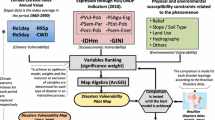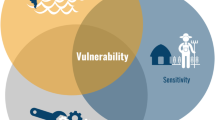Abstract
This paper updates the SCVI (Socio-Climatic Vulnerability Index) maps developed by Torres et al. (2012) for Brazil, by using the new Coupled Model Intercomparison Project Phase 5 (CMIP5) projections and more recent 2010 social indicators data. The updated maps differ significantly from their earlier versions in two main ways. First, they show that heavily populated metropolitan areas – namely Belo Horizonte, Brasília, Salvador, Manaus, Rio de Janeiro and São Paulo – and a large swath of land across the states of São Paulo, Minas Gerais and Bahia now have the highest SCVI values, that is, their populations are the most vulnerable to climate change in the country. Second, SCVI values for Northeast Brazil are considerably lower compared to the previous index version. An analysis of the causes of such difference reveals that changes in climate projections between CMIP3 and CMIP5 are responsible for most of the change between the different SCVI values and spatial distribution, while changes in social indicators have less influence, despite recent countrywide improvements in social indicators as a result of aggressive anti-poverty programs. These results raise the hypothesis that social reform alone may not be enough to decrease people’s vulnerability to future climatic changes. Whereas the coarse spatial resolution and relatively simplistic formulation of the SCVI may limit how useful these maps are at informing decision-making at the local level, they can provide a valuable input for large-scale policies on climate change adaptation such as those of the Brazilian National Policy on Climate Change Adaptation.



Similar content being viewed by others
References
Agrawal A, Lemos MC (2015) Adaptive development. Nat Clim Chang 5:185–187. doi:10.1038/nclimate2501
Barnett J, Lambert S, Fry I (2008) The hazards of indicators: insights from the environmental vulnerability index. Ann Assoc Am Geogr 98:102–119. doi:10.1080/00045600701734315
Blázquez J, Nunes M (2012) Performance of a high resolution global model over Southern South America. Int J Climatol. doi:10.1002/joc.3478
Coutinho RM, Kraenkel RA, Prado PI (2015) Catastrophic regime shift in Water reservoirs and São Paulo Water Supply crisis. PLoS One 10:e0138278. doi:10.1371/journal.pone.0138278
Di Giulio GM, Vasconcellos MP (2014) Contribuições das Ciências humanas para o debate sobre mudanças ambientais: um olhar sobre São Paulo. Estudos Avançados [Online] 28(82):41–63. doi:10.1590/S0103-40142014000300004 Accessed 19 Oct 2015
Eakin H, Luers AL (2006) Assessing the vulnerability of Social-Environmental Systems. Annu Rev Environ Resour 31:365–394. doi:10.1146/annurev.energy.30.050504.144352
Eakin H, Lemos MC, Nelson DR (2014) Differentiating capacities as a means to sustainable climate change adaptation. Glob Environ Chang 27:1–8. doi:10.1016/j.gloenvcha.2014.04.013
Giorgi F (2006) Climate change hot-spots. Geophys Res Lett 33:1–4. doi:10.1029/2006GL025734
Goldewijk K, Beusen A, Janssen P (2010) Long-term dynamic modeling of global population and built-up area in a spatially explicit way: HYDE 3.1. The Holocene 20:565–573. doi:10.1177/0959683609356587
Hinkel J (2011) “indicators of vulnerability and adaptive capacity”: towards a clarification of the science-policy interface. Glob Environ Chang 21:198–208. doi:10.1016/j.gloenvcha.2010.08.002
IPCC (2007) Summary for policymakers. In: Solomon S, Qin D, Mamming M, Chen Z, Marquis M, Averyt KB, Tignor M, Miller HL (eds) Climate change 2007: the physical science basis. Contribution of Working Group I to the Fourth Assessment Report of the Intergovernmental Panel on Climate Change. Cambridge University Press, Cambridge
IPCC (2013) Climate change 2013: the physical science basis. contribution of Working Group I to the fifth assessment report of the intergovernmental panel on climate change. Cambridge University Press, Cambridge
IPCC (2014) Climate change 2014: impacts, adaptation, and vulnerability. Part A: global and sectoral aspects. Contribution of working group II to the fifth assessment report of the intergovernmental panel on climate change. Cambridge University Press, Cambridge
IPEA (Instituto de Pesquisa Econômica Aplicada) (2011). Climate change in Brazil: economic, social and regulatory aspects http://www.ipea.gov.br/agencia/images/stories/PDFs/livros/livros/livro_climatechange.pdf. Accessed 19 Oct 2015
Jones C, Carvalho LMV (2013) Climate change in the South American monsoon system: present climate and CMIP5 projections. J Clim. doi:10.1175/JCLI-D-12-00412.1
Knutti R, Sedlácek J (2013) Robustness and uncertainties in the new CMIP5 climate model projections. Nat Clim Chang. doi:10.1038/nclimate1716
Lindoso DP, Rocha JD, Debortoli N, et al. (2014) Integrated assessment of smallholder farming’s vulnerability to drought in the Brazilian semi-arid: a case study in Ceará. Clim Chang 127:93–105. doi:10.1007/s10584-014-1116-1
Magrin GO, Marengo JA, Boulanger J-P, Buckeridge, MS, Castellanos E, Poveda G, Scarano, FR, Vicuña S (2014) Central and South America. In: Climate Change 2014: Impacts, Adaptation, and Vulnerability. Part B: Regional Aspects. Contribution of Working Group II to the Fifth Assessment Report of the Intergovernmental Panel on Climate Change. Cambridge University Press, Cambridge
Moss RH, Edmonds JA, Hibbard KA, et al. (2010) The next generation of scenarios for climate change research and assessment. Nature 463:747–756. doi:10.1038/nature08823
Patz JA, Campbell-Lendrum D, Holloway T, Foley JA (2005) Impact of regional climate change on human health. Nature 438:310–317. doi:10.1038/nature04188
PNUD (Programa das Nações Unidas Para o Desenvolvimento), IPEA (Instituto de Pesquisa Econômica Aplicada), Fundação João Pinheiro (2013) Atlas do Desenvolvimento Humano no Brasil 2013. http://www.atlasbrasil.org.br/2013/. Accessed 19 Oct 2013
Preston BL, Yuen EJ, Westaway RM (2011) Putting vulnerability to climate change on the map: A review of approaches, benefits, and risks. Sustain Sci 6:177–202. doi:10.1007/s11625-011-0129-1
Räisänen J (2002) CO2-induced changes in interannual temperature and precipitation variability in 19 CMIP2 experiments. J Clim 15:2395–2411
Ranger N (2013) Topic guide: adaptation: decision making under uncertainty. Evidence on Demand. doi:10.12774/eod_tg02.june2013.ranger Accessed 19 Oct 2015
Ranger N, Surminski S (2013) Disaster resilience and post-2015 development goals: the options for economics targets and indicators. Centre for Climate Change Economics and Policy Grantham Research Institute on Climate Change and the Environment. http://www.cccep.ac.uk/Publications/Policy/docs/PP-disaster-resilience-post-2015-development-goals-economics.pdf. Accessed 19 Oct 2015
Ribeiro EM, Galizoni FM (2003) Água, população rural e políticas de gestão: o caso do vale do Jequitinhonha, minas gerais. Ambient Soc 2:129–146. doi:10.1590/S1414-753X2003000200008
Sherbinin A (2014) Climate change hotspots mapping: what have we learned? Clim Chang 123:23–37. doi:10.1007/s10584-013-0900-7
Sillmann J, Kharin VV, Zhang X, Zwiers FW, Bronaugh D (2013) Climate extremes indices in the CMIP5 multimodel ensemble: Part 1. Model evaluation in the present climate. J Geophys Res Atmos. doi:10.1002/jgrd.50203
Taylor KE, Stouffer RJ, Meehl GA (2012) An overview of CMIP5 and the Experiment Design. Bull Am Meteorol Soc. doi:10.1175/BAMS-D-11-00094.1
Torres RR, Marengo JA (2014) Climate change hotspots over South America: from CMIP3 to CMIP5 multi-model datasets. Theor Appl Climatol 117:579–587. doi:10.1007/s00704-013-1030-x
Torres RR, Lapola DM, Marengo JA, Lombardo MA (2012) Socio-climatic hotspots in Brazil. Clim Chang 115:597–609. doi:10.1007/s10584-012-0461-1
UNDP (2014) Human Development Report 2014. Sustaining Human Progress: Reducing Vulnerabilities and Building Resilience. United Nations Development Programme. 1 UN Plaza, New York, NY 10017, USA. 226 p. ISBN 978–92-1-126368-8
Vincent K (2007) Uncertainty in adaptive capacity and the importance of scale. Glob Environ Chang 17:12–24. doi:10.1016/j.gloenvcha.2006.11.009
Walker W, Haasnoot M, Kwakkel J (2013) Adapt or perish: A review of planning approaches for adaptation under deep uncertainty. Sustainability 5:955–979. doi:10.3390/su5030955
World Bank (2010) Development and climate change report. Washington DC, World Bank. doi:10.1596/978-0-8213-7989-5
Xu Y, Xuejie G, Giorgi F (2009) Regional variability of climate change hot-spots in East Asia. Adv Atmos Sci 26(4):783–792
Acknowledgments
This study was supported by São Paulo Research Foundation – FAPESP (grant n° 2013/09742-0), by the Minas Gerais State Research Foundation – FAPEMIG (APQ-01088-14) and the U.S. National Science Foundation (NSF grant n° SES-1061966). We are grateful to T. Siqueira for his helpful suggestions on this study.
Author information
Authors and Affiliations
Corresponding author
Electronic supplementary material
ESM 1
(PDF 346 kb)
Rights and permissions
About this article
Cite this article
Filho, J.P.D., Lapola, D.M., Torres, R.R. et al. Socio-climatic hotspots in Brazil: how do changes driven by the new set of IPCC climatic projections affect their relevance for policy?. Climatic Change 136, 413–425 (2016). https://doi.org/10.1007/s10584-016-1635-z
Received:
Accepted:
Published:
Issue Date:
DOI: https://doi.org/10.1007/s10584-016-1635-z




